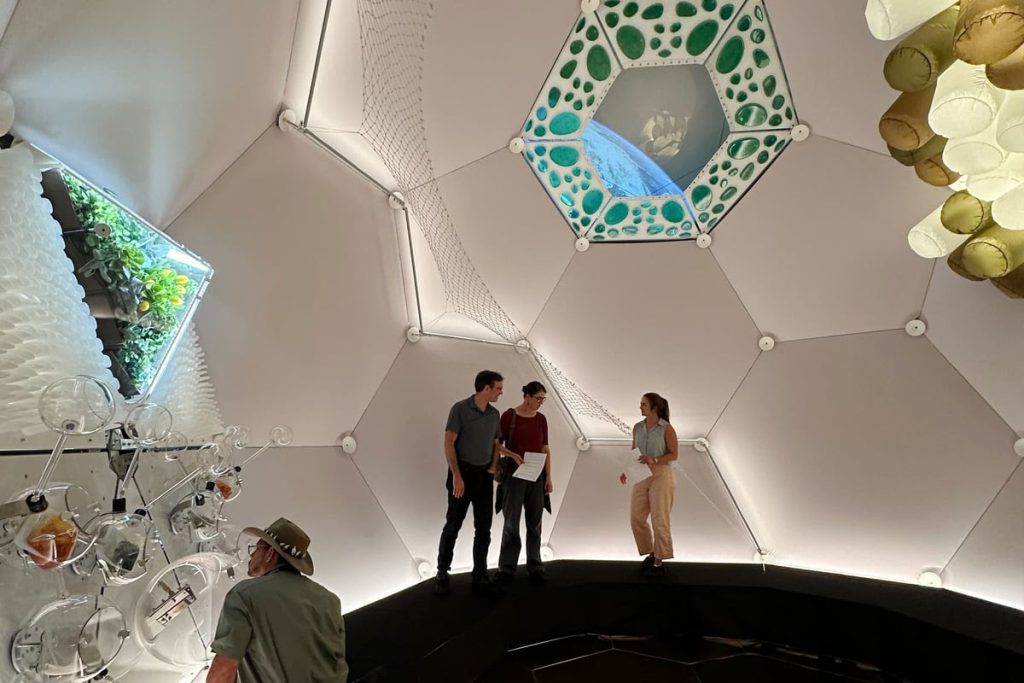The Museum of Flight in Seattle will open a new exhibit called TESSERAE, a life-size space station module, on September 28th. Created by the Aurelia Institute, the 20-foot high by 24-foot wide dome pavilion will allow visitors to step into a mock-up of a futuristic space habitat. TESSERAE, which stands for Tessellated Electromagnetic Space Structures for the Exploration of Reconfigurable, Adaptive Environments, is designed to expand living and working spaces in orbit beyond the traditional cylindrical tubes that have been used in space flight for the past century.
The structure of TESSERAE consists of hexagonal and pentagonal tiles that can be flat-packed for launch and autonomously assembled in space. This platform is modular and customizable, allowing for interior living spaces that focus on comfort and community rather than just basic survival. The exhibit will highlight the importance of food and communal dining in maintaining people’s well-being in space, featuring an aeroponics system for growing fresh produce and showcasing food prep techniques in weightless environments. Additionally, storage solutions inspired by nature, such as algae-filled panels for generating breathable air, and sea anemone-inspired inflatables and nets for navigation within the habitat will also be showcased.
Alongside TESSERAE, the Museum’s “Home Beyond Earth” exhibit offers an immersive experience in three galleries focusing on the past, present, and future of space stations and living in orbit around the Earth. More than fifty artifacts, models, space-flown objects, and uniforms will be on display in this exhibit. The TESSERAE display will be open in the Museum’s Great Gallery until January 12th, providing visitors with the opportunity to explore the innovative and futuristic concept of space habitats and their potential for optimizing living conditions in space.
A rendering video of the assembly process of TESSERAE showcases the self-assembling feature of the space habitat concept. This innovative design and construction method demonstrate the potential for expanding living and working spaces in orbit by utilizing electromagnetically connected tiles that can be assembled in space. The modular and customizable nature of TESSERAE allows for interior living spaces to be optimized for comfort and community, ensuring that future space habitats can prioritize the well-being of their inhabitants.
The TESSERAE exhibit not only showcases advanced technologies for food production in space, such as the aeroponics system and zero-gravity food prep tools, but also highlights creative storage solutions inspired by nature. The algae-filled panels for generating breathable air and sea anemone-inspired inflatables and nets for navigation within the habitat offer functional and aesthetically pleasing options for addressing the challenges of moving and relaxing in zero gravity. By incorporating these elements into the design of space habitats, TESSERAE demonstrates a holistic approach to creating sustainable and comfortable living environments beyond Earth.
Overall, the TESSERAE exhibit at the Museum of Flight in Seattle provides visitors with a unique opportunity to explore the future of space habitation through an immersive and interactive experience. By showcasing innovative design concepts, advanced technologies, and creative solutions for living in orbit, TESSERAE offers a glimpse into how future space habitats could be optimized for the well-being and functionality of their inhabitants. Through this exhibit, visitors can gain a deeper understanding of the challenges and possibilities of living beyond Earth and the potential for creating adaptable and customizable space habitats for future space exploration missions.


